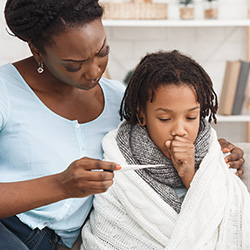
If you have a sick child with flu-like symptoms, it is not always easy to tell when they may need medical care. Knowing which flu symptoms are more serious can help you know when to take your child to the doctor.
In children, emergency symptoms of the flu include:
- Inconsolable irritability
- Labored breathing and a persistent cough
- Neck stiffness
- Confusion
If your child is experiencing any of the above symptoms, bring them to the nearest emergency room to be seen immediately. However, most healthy children with flu-like symptoms can be treated at home or by their primary care doctor. Consider checking with your pediatrician first before heading to the ED.
Children’s hospitals and their emergency departments across the country, including Baystate Children’s Hospital in Springfield, are experiencing an unprecedented spike in cases of respiratory illness that are filling their hospital and emergency beds to capacity.
According to the CDC’s current flu activity map, Massachusetts is seeing very high flu activity.
"Our region is now seeing a surge in influenza on top of higher than normal other respiratory viruses. These viruses can cause mild to moderate, even severe symptoms. It is not too late to get a flu vaccine and a COVID-9 booster,” says Dr. Charlotte Boney, Pediatrician-in-Chief, Baystate Children’s Hospital, who notes that many parents are turning to the emergency department for care before checking with their pediatrician first.
What to Do if Your Child is Sick
Most healthy children may be treated at home with fluids and fever-reducing medicines that don’t contain aspirin. Flu-like symptoms, including fever, can often last 5-7 days, and for most patients, increasing fluid intake and taking fever-reducing medications (that do NOT contain aspirin) work effectively. Some pharmacies and stores may be experiencing shortages of children’s cold medicine – read our tips for how to handle this challenge.
The Sadowsky Family Pediatric Emergency Department at Baystate Children’s Hospital provides treatment for medical emergencies 24/7.
"While the Pediatric Emergency Department is experiencing long wait times because of the surge in these respiratory illnesses, we ask that if your child has moderate or severe cold symptoms, please call your child’s primary care provider first to discuss your child’s symptoms. In mild to moderate cases, fluids and symptom relief for fever, congestion and cough can be helpful," says Dr. Boney.
When to Call Your Pediatrician
Your child needs medical care if they have the following symptoms:
- Any fever over 100.4 in an infant less than 3 months old
- If you child has a chronic medical condition
- Fever that does not respond to fluids, rest, and fever-reducing medications or last longer than 5 days
- Extreme fatigue
- Headache that does not go away
- Wheezing
- Vomiting and/or signs of dehydration (decreased urination or decreased tears when crying)
- Back pain
- Weak legs or feet
- Severe muscle pain
- Red urine
When to Go to the Pediatric Emergency Room
Dr. Boney recommends visiting the pediatric emergency department if your child has:
- Inconsolable irritability
- Labored breathing and a persistent cough
- Neck stiffness
- Confusion
Learn more about where to go when you're sick: the emergency room, convenient care, or primary care.
Flu and Other Respiratory Bugs
The respiratory bugs striking early and currently contributing to packed hospitals this fall include RSV (respiratory syncytial virus), enterovirus, and rhinovirus.
RSV is a common respiratory virus that usually causes mild, cold-like symptoms. Most people recover in a week or two, but RSV can be serious, especially for infants and older adults. RSV is the most common cause of bronchiolitis (inflammation of the small airways in the lung) and pneumonia (infection of the lungs) in children younger than 1 year of age in the United States.
Many different respiratory viruses can cause the common cold, but rhinoviruses are the most common. Rhinoviruses can also trigger asthma attacks and have been linked to sinus and ear infections.
Learn more about RSV symptoms and what to watch for at healthychildren.org.
Common Flu Symptoms in Kids
A child with the flu will typically experience:
- Fever
- Chills
- Headache
- Runny nose
- Cough
- Nausea
- Fatigue
- Loss of appetite
- Sore throat
Common Cold and Respiratory Symptoms
Most people who get infected with non-polio enteroviruses do not get sick, or they only have mild illness, like the common cold.
Symptoms of mild illness can include fever, runny nose, sneezing, cough, skin rash, mouth blisters, and body and muscle aches.
Get Your Flu Shot
Increased flu vaccination for both adults and children could help reduce the risk of a more severe flu season.
“Be sure you and your child get your yearly influenza vaccine right now and your COVID booster when eligible,” says Dr. Boney.
Learn more about getting your flu shot.